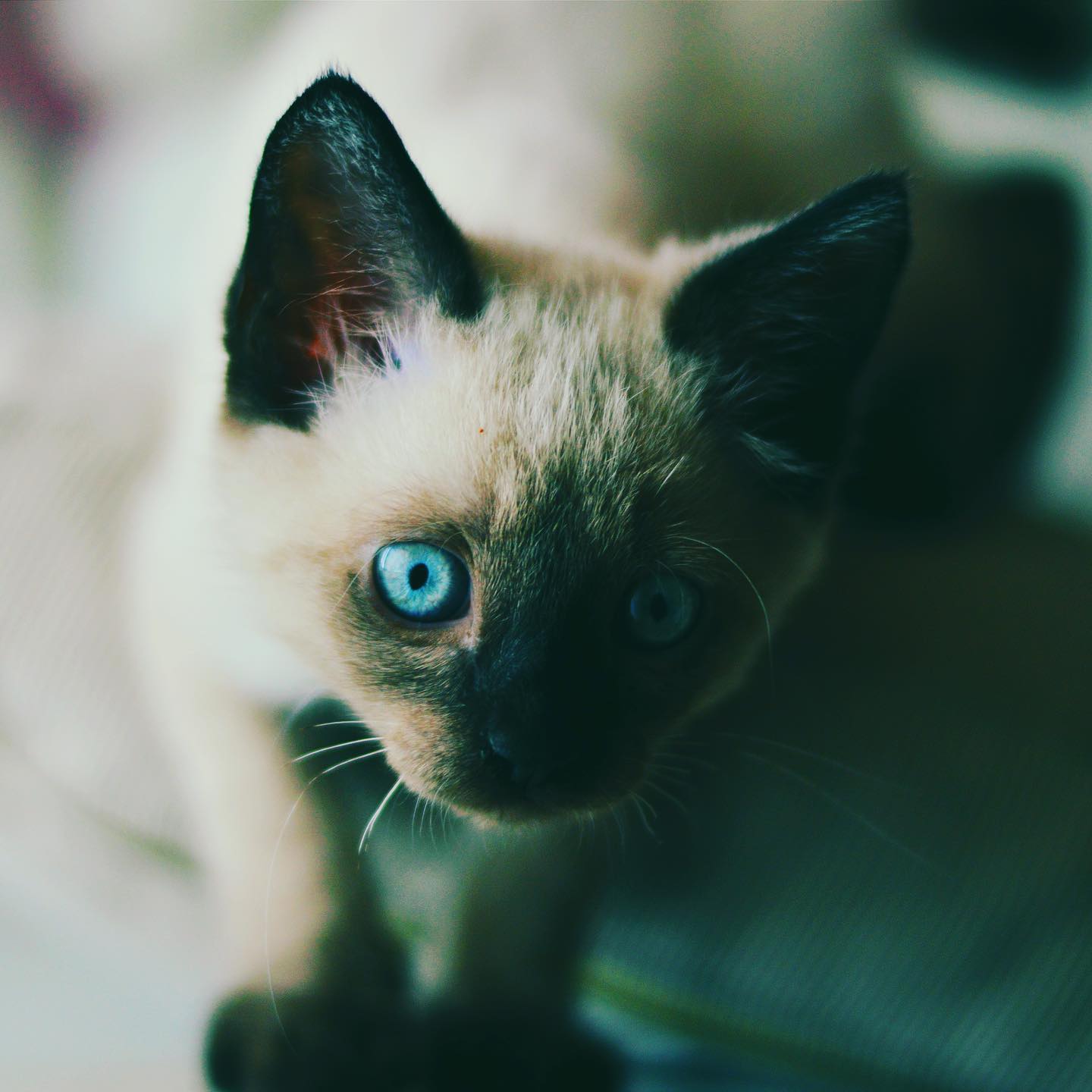Can Cats Have Ice Cream? Here’s What You Need to Know As a devoted cat parent, I remember my cat looking at my ice cream. It’s tempting to share, but it’s important to know if cats can have ice cream. This is key for their health.
Cats and ice cream might look cute together, but it’s more complicated. Cats need a special diet, and ice cream could be harmful. It’s important to understand their nutritional needs.
Vets say cats need to eat mostly meat. Ice cream is too sweet and can cause problems. It can lead to digestive issues and weight gain.
Knowing the risks is important for pet owners. Even though cats might look at you with pleading eyes, it’s better to avoid ice cream. This can prevent vet visits and keep your cat healthy and happy.
Table of Contents
Understanding Ice Cream and Its Ingredients
Ice cream might look like a tasty treat, but it’s dangerous for cats. It’s not a good choice for cats to eat frozen treats.
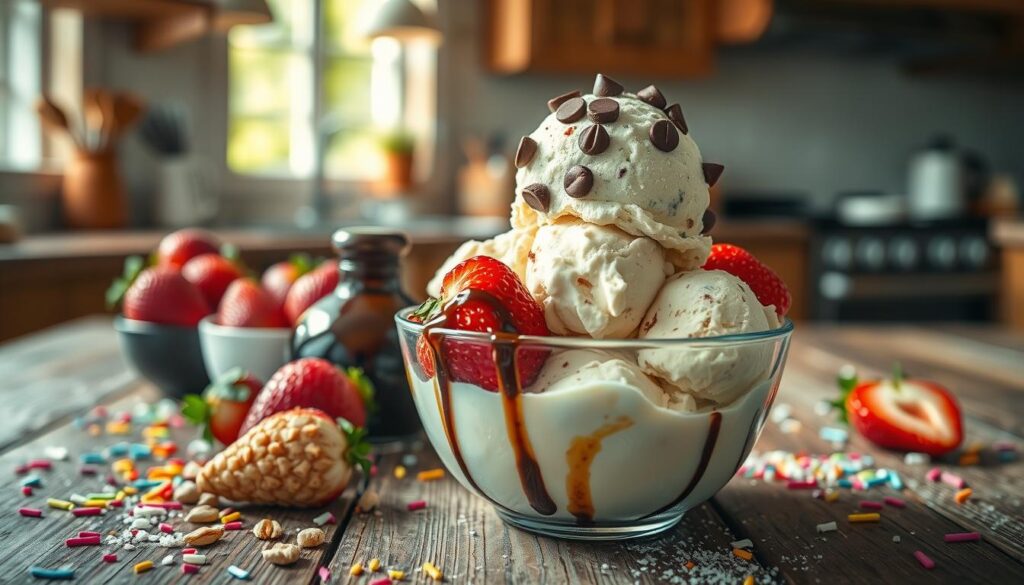
Cats need special food that humans shouldn’t give them. Ice cream has ingredients that can hurt cats.
What Is Ice Cream?
Ice cream is made of:
- Milk or cream
- Sugar
- Flavoring agents
- Stabilizers and emulsifiers
Nutritional Composition of Ice Cream
Ice cream is not good for cats. A half-cup has:
| Nutrient | Amount |
|---|---|
| Calories | 125-150 |
| Sugar | High |
| Fat | Significant |
Common Ice Cream Flavors and Additives
Be careful with ice cream for cats. Some things in ice cream are bad for cats. These include:
- Chocolate (very bad for cats)
- Xylitol (artificial sweetener)
- Raisins
- Caffeine
“Understanding ice cream helps see why it’s bad for cats.” – Veterinary Nutrition Experts
Cats can’t taste sweetness and have fewer taste buds than humans. They don’t enjoy ice cream like we do. It’s not good for them.
Can Cats Safely Consume Ice Cream?
Ice cream is not good for your cat. Cats need special food that humans don’t. Most human treats can harm them.
It’s important to know the dangers of cats eating dairy. About 70% to 80% of cats can’t digest milk well. They lack the enzyme lactase.
Recommended Amounts for Cats
The right amount of ice cream for cats is zero. They should never have ice cream. It’s bad for their health in many ways:
- Too much fat can make them gain weight
- It can upset their stomach
- It’s not good for their diet
- Artificial sweeteners can be toxic
Signs of Ice Cream Intolerance
If your cat eats ice cream by mistake, look out for these signs:
| Symptom | Severity |
|---|---|
| Vomiting | High |
| Diarrhea | High |
| Stomach Cramps | Medium |
| Loss of Appetite | Medium |
| Lethargy | Low |
“Cats cannot taste sweetness, so ice cream offers no flavor enjoyment for them – only potential health risks.” – Veterinary Nutrition Expert
So, can cats eat dairy? No, they shouldn’t. Their health depends on the right food.
Potential Risks of Ice Cream for Cats
Ice cream is not safe for cats. It can harm their health. Cats might want to try it, but it’s not good for them.
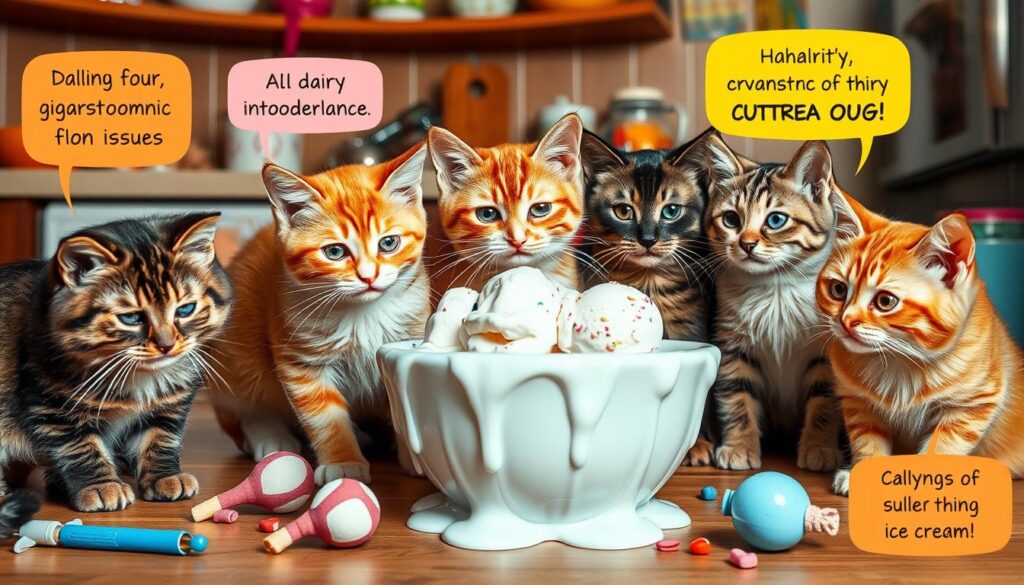
Cats need special food, not ice cream. Knowing the dangers helps keep them healthy.
Lactose Intolerance and Digestive Challenges
About 70% of adult cats can’t digest lactose. This means ice cream can cause big problems. Cats might get:
- Painful stomach cramps
- Diarrhea
- Vomiting
- Bloating
Weight Management Concerns
Ice cream is bad for a cat’s weight. It has too much sugar and fat. Vets say treats should be just 10% of a cat’s diet.
| Nutritional Concern | Potential Impact |
|---|---|
| Sugar Content | Increases risk of diabetes |
| Fat Percentage | Promotes unhealthy weight gain |
| Caloric Density | Exceeds recommended treat limits |
Dental Health Implications
Sugar in ice cream harms a cat’s teeth. It can cause cavities and gum disease. This can hurt their mouth and need vet care.
“Prevention is always better than cure when it comes to your cat’s nutrition.” – Veterinary Nutrition Expert
Some ice cream has dangers like chocolate or xylitol. These can be toxic and potentially life-threatening for cats.
Nutritional Needs of Cats vs. Ice Cream Content
It’s important to know what cats need to eat. They might like human treats like ice cream, but their diet is very different from ours.

Cats need certain nutrients that ice cream doesn’t have. Their diet should include lots of protein to help their bodies work right.
Feline Dietary Requirements
A cat’s best diet includes:
- 40-50% high-quality protein
- Moderate fat content
- Minimal carbohydrates
- Essential amino acids
Comparison with Ice Cream Nutrition
Ice cream and cats don’t match up well. Ice cream has:
- High sugar content
- Excessive calories
- Lactose that cats can’t digest
- Zero essential nutrients for felines
“Cats lack the digestive enzymes to process dairy products effectively, making ice cream a nutritionally empty treat.”
Impact on Cat’s Health
Feeding cats ice cream can harm their health. The sugar and fat can cause:
- Weight gain
- Potential diabetes
- Digestive issues
- Nutritional imbalances
Veterinary nutritionists strongly recommend avoiding human treats and focusing on species-appropriate nutrition for optimal feline health.
How to Handle Accidental Ice Cream Consumption
Discovering your cat has eaten ice cream can be stressful. Knowing the dangers of ice cream for cats and how to act can protect your pet.
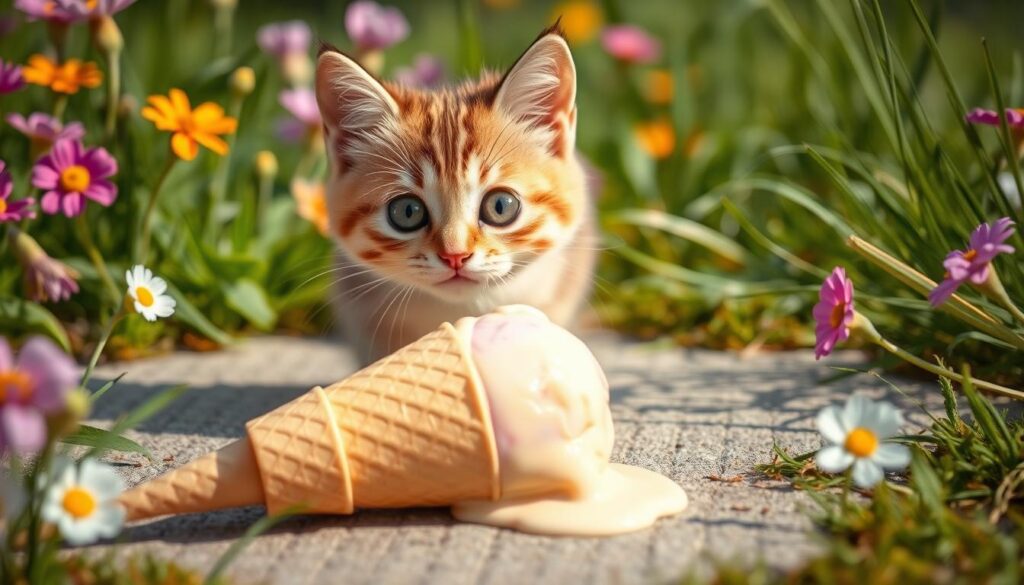
Immediate Response Steps
Act fast if your cat eats ice cream. Here’s what to do:
- Check the ice cream ingredients right away
- Look for toxic stuff like chocolate or xylitol
- Take away any ice cream your cat might find
- Give your cat fresh water to help with digestion
Monitoring Your Cat’s Symptoms
Cats react differently to ice cream. Watch for these signs:
| Symptom | Potential Severity |
|---|---|
| Vomiting | Mild to Serious |
| Diarrhea | Moderate Risk |
| Lethargy | Potential Concern |
| Excessive Thirst | Digestive Distress |
When to Contact a Veterinarian
Not every ice cream incident needs a vet visit. But, if unsure, call your vet if:
- Symptoms last more than 12 hours
- Your cat seems very upset
- The ice cream had chocolate or fake sweeteners
- Your cat has health issues
“Early action can greatly help your cat recover from ice cream problems.” – Veterinary Nutrition Experts
Prevention is key. Keep ice cream and harmful foods away from your cat to keep them safe and healthy.
Safe Alternatives to Ice Cream for Cats
Cats enjoy treats, but ice cream isn’t good for them. Look into ice cream alternatives for cats. These options are tasty and healthy for your pet.
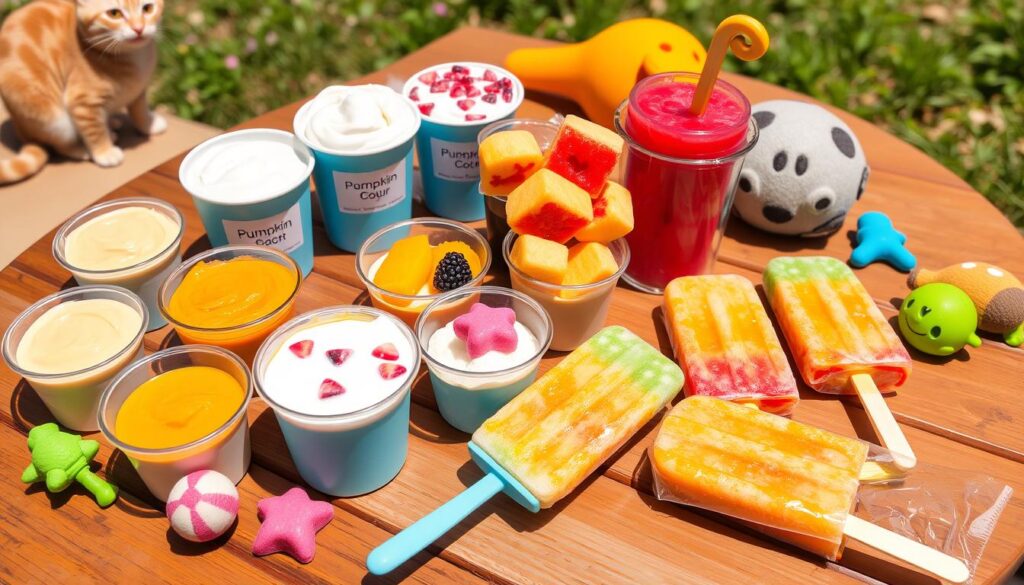
When looking for desserts for cats, consider these safe and tasty options. They will make your cat very happy.
Commercial Cat Treats
Professional cat treats are made with your cat’s needs in mind. They have:
- High-protein content
- Minimal artificial additives
- Veterinarian-approved ingredients
Homemade Frozen Cat Treats
Making treats for cats at home is fun and healthy. Here are some tasty recipes:
| Treat Type | Key Ingredients | Preparation Time | Freezing Duration |
|---|---|---|---|
| Tuna Ice Cream | Water-packed tuna (12-15 oz) | 15 minutes | 3 hours |
| Pumpkin Cubes | Chicken livers, pumpkin puree | 20 minutes | 4-6 hours |
| Blueberry Treat | 1/3 cup blueberries | 10 minutes | 3 hours |
Other Safe Human Foods for Cats
Some human foods can be treats for cats. Remember to introduce new foods gradually and in small quantities:
- Lean meats (chicken, beef, pork)
- Cooked eggs
- Small amounts of pureed pumpkin
- Plain, unsweetened yogurt
“Treats should comprise no more than 10% of a cat’s daily diet to maintain optimal health.” – Veterinary Nutrition Experts
Always talk to your vet before trying new foods. This ensures they’re right for your cat’s health.
Expert Opinions on Cats and Ice Cream
Vets and pet nutritionists have clear views on cats and ice cream. Their advice can guide you in choosing the right diet and treats for your cat.
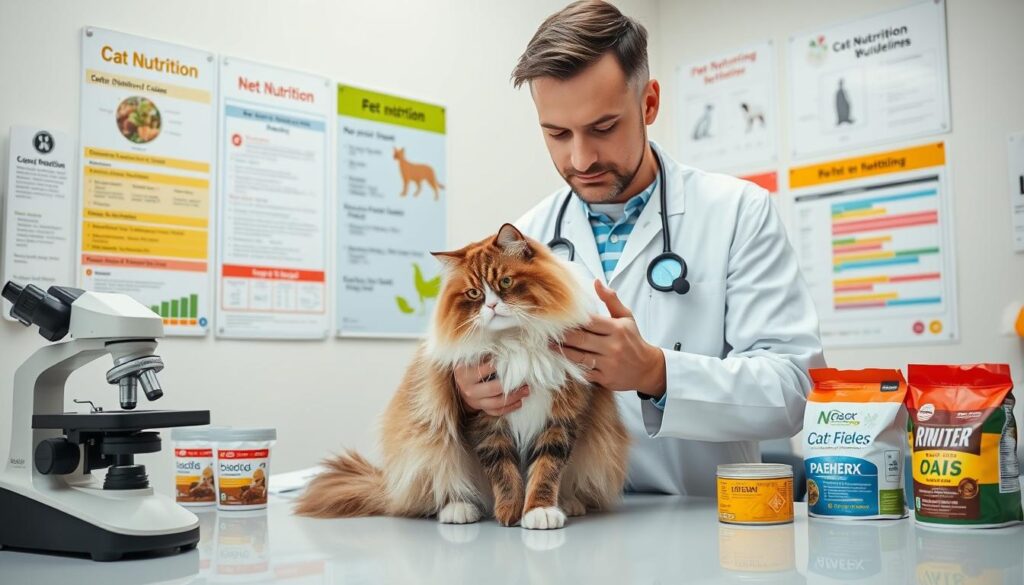
Veterinarian Insights on Feline Diet
Vets strongly advise against giving ice cream to cats. Cats need a diet rich in meat, not dairy. About 70-80% of adult cats can’t digest lactose, making ice cream risky.
“Cats’ digestive systems are not designed to process dairy products like ice cream. Stick to species-appropriate nutrition.” – Dr. Sarah Thompson, Feline Nutrition Specialist
Pet Nutritionists’ Perspectives
Pet nutritionists also warn about the dangers of ice cream for cats. They point out several key concerns:
- High sugar content (20-30%) can lead to obesity
- Potential digestive issues in 50% of cats
- Risk of pancreatitis in 15-20% of cases
- Dental problems affecting up to 80% of cats
Experts suggest safe options for your cat’s diet and treats:
- Consult with a vet before trying new foods
- Choose cat-specific treats
- Stay away from human food that’s not good for cats
Always prioritize your cat’s health by selecting treats specifically designed for feline nutrition.
Myths and Misconceptions about Cats and Dairy
The image of a cat drinking milk is common in movies and TV shows. But, it’s not true for most adult cats. They can’t safely eat dairy products like ice cream.
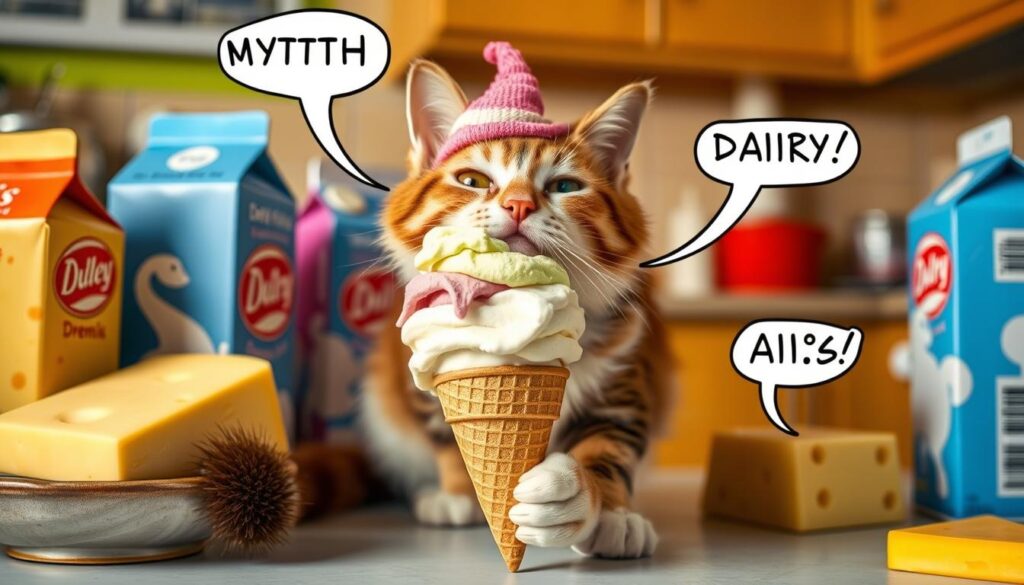
- Myth: All cats love milk
- Reality: Most adult cats are lactose intolerant
- Myth: Dairy is a healthy treat for cats
- Reality: Dairy can cause significant digestive issues
The Milk-Loving Cat Stereotype
About 70-90% of adult cats can’t digest milk well. Kittens can, but they lose this ability as they grow up. So, giving cats ice cream is not safe.
Debunking Common Beliefs
Studies show that dairy can hurt cats’ stomachs. It can cause:
- Vomiting
- Diarrhea
- Abdominal pain
- Bloating
Education on Feline Nutrition
Cats need a diet rich in protein. They are meat-eaters. Dairy, like ice cream, is not good for them.
“Cats’ dietary needs are unique. What seems like a treat to us can be harmful to them.” – Veterinary Nutrition Expert
| Dairy Consumption Impact | Percentage of Cats Affected |
|---|---|
| Lactose Intolerance | 70-90% |
| Digestive Distress | 50-60% |
| Potential Weight Gain | 40-50% |
Choose treats wisely for your cat. Pick ones made just for cats to keep them healthy and happy.
The Impact of Human Food on Cat’s Overall Diet
Knowing how to balance your cat’s diet is key for pet care. Cats need a specific mix of nutrients to stay healthy.
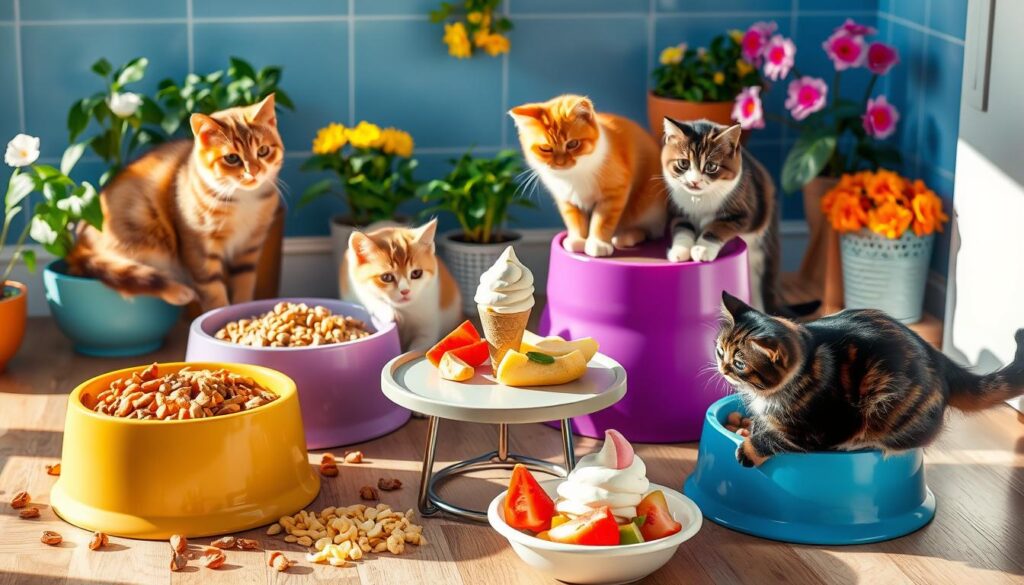
Adding human foods or frozen treats can upset their diet. Experts say treats should not make up more than 10% of their daily calories.
Balancing Treats with Regular Cat Food
It’s important to keep treats and regular food in balance. Here are some tips:
- Choose high-quality cat food as the main diet
- Use treats sparingly as rewards
- Watch your cat’s weight and health
Importance of Portion Control
| Food Type | Recommended Percentage | Potential Risks |
|---|---|---|
| Regular Cat Food | 90% | Balanced nutrition |
| Treats | 10% | Potential weight gain |
Long-term Effects of Improper Feeding
Bad feeding habits can cause serious health issues. Nutritional imbalances may lead to:
- Obesity
- Diabetes
- Digestive problems
- Dental issues
“Nutrition is the foundation of your cat’s health. What you feed determines how they live.” – Veterinary Nutrition Expert
Understanding the link between diet and treats helps. You can make sure your cat gets the right nutrition and enjoy special snacks now and then.
Creating Cat-Friendly Frozen Treats at Home
Summer makes us all want cool treats, and cats are no exception. They deserve safe, tasty ice cream alternatives. Making homemade desserts for your cat is a fun way to keep them healthy and happy.
Safe Ingredients for Cat Treats
Choosing the right ingredients is key when making cat-friendly desserts. Here are some safe options:
- Lactose-free yogurt
- Low-sodium chicken broth
- Pureed tuna or salmon
- Goat’s milk
- Mashed banana
Simple Recipes to Try
Try these easy recipes for fun frozen treats:
- Tuna Ice Cubes: Mix 2 parts tuna with 1 part water, freeze in ice cube trays
- Chicken Broth Pops: Pour low-sodium chicken broth into molds
- Yogurt Banana Freeze: Blend lactose-free yogurt with ripe banana
“Homemade treats allow you to control ingredients and portion sizes for your cat’s health.” – Veterinary Nutrition Expert
Serving and Storage Tips
Here’s how to serve these treats safely:
- Serve treats in small portions
- Store in sealed containers in the freezer
- Introduce new treats gradually
- Monitor your cat’s reaction to new foods
These cat-friendly desserts are a refreshing summer treat. They support your cat’s health and keep them cool and happy.
Conclusion: Making Informed Decisions About Cat Treats
When thinking about whether cats can have ice cream, pet owners should put their cat’s health first. It’s important to choose safe treats that meet their nutritional needs without risks.
Navigating Feline Dietary Choices
Your cat needs special care when it comes to food. Ice cream is not safe and can harm your cat more than it can please them. Knowing the dangers helps you make better choices for your pet.
Key Risks of Inappropriate Cat Treats
- Digestive complications from lactose intolerance
- Potential weight gain and obesity
- Risk of diabetes development
- Potential toxic ingredient exposure
Responsible Pet Nutrition Strategies
Choosing the right treats means knowing what your cat needs. Veterinary guidance is key in making these choices. Cats have fewer taste receptors than humans, with only 470 compared to about 9,000 in humans.
“Your cat’s health is determined by the choices you make in their diet.” – Veterinary Nutrition Expert
Recommended Approach
- Consult veterinary professionals
- Choose cat-specific treats
- Avoid human food substitutions
- Monitor your cat’s dietary responses
Too much sugar and wrong ingredients can cause serious health problems. Overweight cats are at risk for arthritis, high blood pressure, and serious diseases like diabetes and cancer.
Final Recommendation
Focus on cat-specific nutrition. Ice cream might look tempting, but it’s a big health risk. Your cat depends on you to make good food choices that keep them healthy for a long time.
Additional Resources for Cat Nutrition
Finding the right food for your cat can be tricky. It’s important to know what they need to stay healthy. This knowledge helps you make good choices for their diet.
Recommended Books and Websites
Look for reliable sources on cat food and treats. The Cornell Feline Health Center and ASPCA have great online guides. “The Cat Owner’s Home Veterinary Handbook” by Dr. Michael Garvey is also a good read. It dives deep into what cats need to eat and what might be harmful.
Consulting with Veterinary Professionals
Your vet is the best person to talk to about your cat’s diet. They can create a diet plan that’s just right for your cat. They can also suggest safe treats and help with any health issues.
Going to the vet regularly is key. It helps make sure your cat gets the nutrients they need at every stage of their life.

